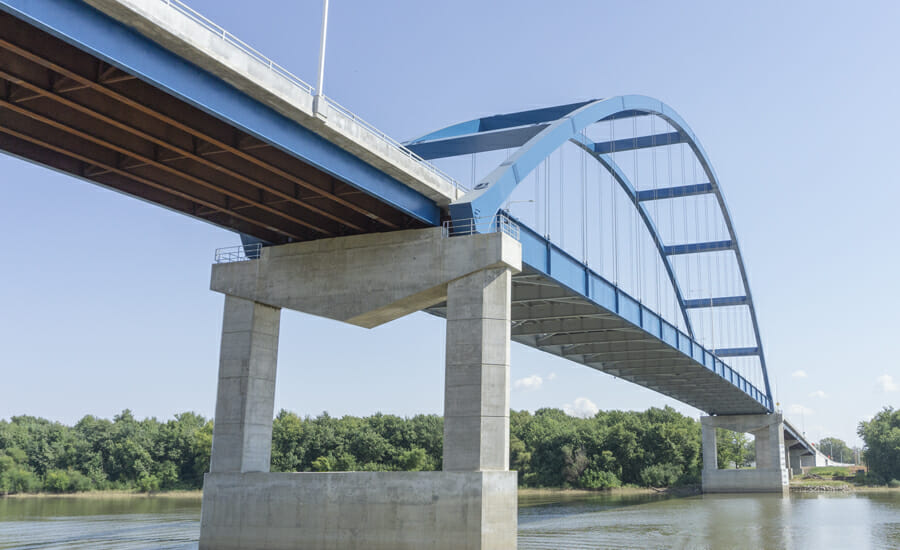The new Illinois Route 104 (IL-104) bridge over the Illinois River is a story about collaboration, partnership and community. As an important project for the region, I am excited about how our team, the Illinois Department of Transportation (IDOT) and the community converged to find viable and innovative solutions.
IL-104 crosses the Illinois River in the village of Meredosia, a small, rural community in Morgan County, IL. Built in 1936, the existing two-lane truss bridge was deemed functionally obsolete and structurally deficient. As a backbone of the region’s transportation network, the existing bridge was important to residents, the region’s many farmers, commercial trucking interests and other businesses in the region. Closure of the bridge would have significant adverse impacts on traffic and the region’s economy.
Our team embarked upon a preliminary engineering study and environmental assessment (EA), as well as final design for the bridge’s replacement. The new bridge had to meet or exceed current design standards, accommodate bicycle and river traffic, fulfill local and regional economic needs, and be reliable for the next 100 years.
In total, we studied 17 different alternatives, including rehabilitation of the existing bridge, reconstruction on the existing alignment and a new bridge on a new alignment.
Early in the planning process, we discovered that residents and business owners feared that relocating the bridge to bypass the village would have severe economic impacts on the community. Further complicating the project were numerous other factors, including the presence of historic properties, archaeological sites, a National Wildlife Refuge, public park space, threatened and endangered species, wetlands, hazardous materials and floodplains, to name a few. With so many varying factors, we recognized how critical community input and stakeholder involvement would be from the beginning.
Using IDOT’s Context Sensitive Solutions (CSS) approach, we actively engaged the community and other project stakeholders in a robust public outreach process, incorporating community and public meetings, newsletters and a website. Throughout the planning phase, an advisory committee of local representatives and stakeholders known as the Meredosia Bridge Advisory Committee (MBAC) provided direct input regarding the community’s views and concerns.
Concurrently, we were coordinating with more than 10 different federal and state agencies and 14 Native American Tribes. Where such impacts and the potential for agency/community conflict exist, achieving consensus and obtaining agency approvals could have been challenging. We took a proactive approach through the CSS process to identify the needs and desires of the community early in the study, while also integrating early agency coordination. As a result, we overcame typical issues that might have led to a different solution than the ideal solution the community and IDOT desired.
Through a strong partnership with IDOT, we were able to successfully mitigate impacts to a National Wildlife Refuge through an innovative land-swap deal that enabled US Fish & Wildlife to enhance the refuge in exchange for refuge land to build the new bridge at the desired location. Reconfiguration of Boyd Park, a public park, made it more usable for the surrounding community and the nearby schools. Finally, as part of the CSS process, EXP and IDOT worked with the Village to develop a downtown plan that would not only minimize impacts to the business district, but also maintain connectivity to and improve visibility of local businesses to traffic on the newly realigned IL-104.
The preliminary engineering study resulted in the selection of a new 2,125-foot-long bridge located approximately 255 feet north of the existing bridge. A unique feature of the new bridge is a 590-foot-long tied-arch span over the navigational channel of the Illinois River. The new bridge would impact less acreage of wetlands and farmland; cost less to build and maintain; cause lesser or no adverse economic impacts; and importantly, was supported by the local community and municipality.
Our team went on to provide final design engineering for the new bridge and it opened to a community audience in June 2018. As one of only a handful of IDOT’s tied-arch bridges, the new crossing has created a gateway for the region. Visible from a distance, its design is both innovative yet illustrative of EXP’s simple and direct approach to design. However, the magic of the IL-104 project not only lies in its engineering, but also in a process marked by collaboration and partnership. Through diligent cooperation, we successfully turned potentially diverging views into a convergent solution. The result is a new legacy for the region and a bridge that will be a striking monument for the next 100 years!
Vinod Patel, SE, PE | Department Manager, Bridges + Structures | Chicago, IL
*Originally published in EXP’s Expresso: Convergence

